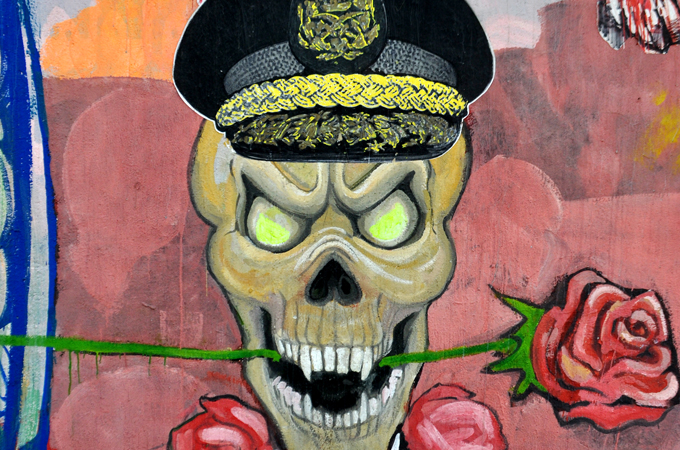Egypt’s graffiti artists make their mark
Cairo’s graffiti scene has evolved as an arena for protest and a way for young artists to tackle social issues.

Egyptian graffiti artist Mohamed Ismail, 22, cannot walk through West Cairo’s Ard el-Lewa neighbourhood without being mobbed by schoolchildren.
Ismail and fellow artist Mustafa Ali, aka “Boogie”, are giving a guided walking tour of their latest street art project, a series of portraits of local children. The work has made Ismail a celebrity in this low-income neighbourhood; the “Face Project”, he says, is a new direction for his street art collective, the Mona Lisa Brigade.
First formed in 2010, the Brigade and other groups were at the forefront of the 2011 Arab Spring revolt that overthrew former President Hosni Mubarak. “We were with the revolution from the start,” Ismail said. “All the people on the ground were the same way.”
IN VIDEO: Graffiti convey stories of Egypt revolution
At the height of the revolution, murals protesting military rule and celebrating the regime’s political victims became icons of the Egyptian zeitgeist. But more than three years since Mubarak’s ouster, a sense of political fatigue and confusion has set in.
Many street artists view former general and current presidential candidate Abdel Fattah el-Sisi as merely the new face of an old system. Murals depicting Muslim Brotherhood supporters as sheep run side-by-side with images of military men as butchers. The murals frequently shift and change, with different artists perpetually defacing or enhancing earlier works.
 |
|
Graffiti critical of the new ruling system is plentiful [Transterra/Al Jazeera] |
Continued unrest has given artists no shortage of material to work with, but Egypt’s crackdown on dissenting voices – 500 members of the now-outlawed Muslim Brotherhood were recently sentenced to death – has made it more difficult for Cairo’s artists to design the murals that became the icons of Egypt’s uprising.
“The current public sentiment actually does make it more dangerous for graffiti artists to express themselves freely,” said Don Karl, co-editor and publisher of Walls of Freedom, a compilation of photographs and essays on Egyptian graffiti since 2011. “The slightest critique and you can be accused of being one of the ‘terrorists’.”
Meanwhile, a variety of Egyptian street artists have begun tackling other social issues, including gender disparity. Women on Walls (WOW), founded by Mia Grondahl, says the group’s work is inspired by disturbing statistics: According to a recent UN report, 99.3 percent of women in Egypt claim to have been sexually harassed, and the country has struggled with high rates of female genital mutilation, despite a ban on the practise there.
Between January of 2011 and May of 2012, Grondahl said, she surveyed around 17,000 pieces of street art and found just 253 images featuring women. Earlier this year, a WOW workshop encouraged women to think of the most offensive word men had called them, and to write it on the wall.
“If you want to tell people something in Egypt, you’ve got to tell them in the street,” said workshop participant Enas Awad, 21. “They spend 75 percent of their day in the street. You’ve got to go straight to the people.”
Someone wanted to make a statement.
But passersby have sometimes seemed fearful of the images, Grondahl said, noting one man saw a painting-in-progress of a woman’s leg, and asked nervously: “Is this a military boot that she’s painting? No, no, no, nothing anti-Sisi.”
INTERACTIVE: Egypt’s tumult told by the art it inspired
Graffiti critical of the new ruling system is still plentiful in Cairo, with comments such as “Sisi is a murderer.” or “Down with the Brotherhood,” popping up on overpasses and street signs.
Street art is all about “strengthening the people, being with the people, listening to the people”, Grondahl said – but the people do not always agree. Both Mona Lisa Brigade and WOW have cited instances of community backlash to their controversial images; recently, residents of Ard el-Lewa began systematically painting over each of the faces created by the Brigade.
“Someone wanted to make a statement, but that’s okay – it’s in the streets, these things happen,” Ismail responded. “We’ll maybe make a stencil over it.”